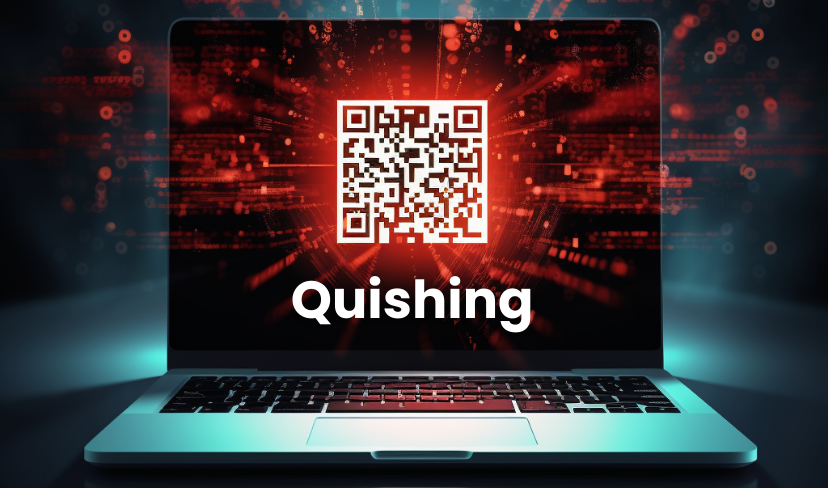Opening your camera app and scanning QR codes has been such a quick way to access the information you need, but these codes might not always be what you believe they are.
Quishing, a new cyber threat player has entered the field!
A combination of “QR” and “phishing,” Quishing is the practice of using QR codes to launch phishing attacks. These cyberattacks deceive people into disclosing private information, including login passwords or personal information. The Federal Trade Commission (FTC) issued a consumer advisory alerting people to the possibility that malicious links could be concealed behind QR codes. Quishing risks are rising in parallel with QR codes’ increasing presence in everyday life, from product packaging to restaurant menus.
This sophisticated form of phishing poses a significant risk to individuals and businesses alike. In this blog post, brought to you by Transputec, we will delve into the world of Quishing, exploring what it is, how it works, and why businesses must be vigilant against this emerging threat.
Let us first understand – what is a QR Code.
What is a QR Code
A QR code (a Quick Response Code) is a square-shaped image resembling a barcode. It is used for various purposes, such as providing quick access to internet-based resources like websites, product or event information, and payment facilities. You can scan the QR code with your smart device’s camera to access its information.

What is Quishing
Quishing is a type of phishing scam that uses QR codes to lure people to fake websites. QR codes are square-shaped barcodes that can be scanned by smartphones and other devices with a camera and a QR code reader app installed. They are often used to provide quick access to internet-based resources like websites, product or event information, and payment facilities.
Scammers use QR codes to carry out quishing attacks by creating fake QR codes that look legitimate. When a person scans the fake QR code, it takes them to a fake website that looks like a legitimate one. The fake website then prompts the person to enter sensitive information like login credentials, financial information, or personal data.
How Does Quishing Work
Quishing works by exploiting the trust that people have in QR codes. People often assume that QR codes are safe to scan, and they don’t think twice before scanning them. Scammers take advantage of this trust by creating fake QR codes that look legitimate.
When a person scans the fake QR code, it takes them to a fake website that looks like a legitimate one. The fake website then prompts the person to enter sensitive information like login credentials, financial information, or personal data. Once the person enters the information, the scammers can use it for fraudulent purposes.
What Happens If You Scan a Fraudulent QR Code

If you scan a fraudulent QR code, you could be taken to a fake website that looks like a legitimate one. The fake website may prompt you to enter sensitive information like login credentials, financial information, or personal data. If you enter the information, the scammers can use it for fraudulent purposes.
The Quishing Challenge
Detecting Quishing attacks presents a significant challenge. The seamless integration of QR codes into our daily lives makes it difficult to distinguish between legitimate and malicious codes. Cybercriminals capitalise on this familiarity to execute attacks without raising suspicion.
How to Detect a Quishing Attack
The best way to detect a quishing attack is to be aware of the risks and to be vigilant when scanning QR codes. Here are some tips to help you detect a quishing attack:
| Be wary of QR codes that look suspicious or that you don’t recognise. |
| Check the URL of the website that the QR code takes you to. If it looks suspicious or doesn’t match the website you were expecting, don’t enter any information. |
| Look for signs that the website is fake, such as poor grammar or spelling mistakes. |
| Be cautious when entering sensitive information like login credentials or financial information. |
How to Prevent a Successful Quishing Attack
Preventing Quishing attacks requires a combination of awareness, education, and technology. Implement security measures such as QR code scanning apps that can verify the legitimacy of codes before opening them. Educate employees and customers on the risks associated with scanning unknown QR codes, promoting a culture of cybersecurity awareness. The best way to prevent a successful quishing attack is to be proactive and to take steps to protect yourself. Here are some tips to help you prevent a successful quishing attack:
| Be cautious when scanning QR codes. Only scan codes that you trust and that you recognise. |
| Use a QR code scanner that has built-in security features. Look for scanners that can detect fraudulent QR codes and that can alert you to potential risks. |
| Use two-factor authentication whenever possible. This will add an extra layer of security to your accounts and will make it harder for scammers to access your information. |
| Keep your software up-to-date. Make sure that your operating system, apps, and security software are all up-to-date to protect against the latest threats. |
Transputec’s Commitment towards Quishing Awareness
At Transputec, we understand the evolving nature of cyber threats and the importance of staying ahead of the curve. Our comprehensive cybersecurity solutions are designed to safeguard businesses against emerging threats like Quishing. By combining advanced technology with proactive education initiatives, we empower organisations to navigate the digital landscape securely.
Conclusion
In conclusion, quishing is a new type of phishing scam that uses QR codes to trick people into revealing sensitive information. Scammers create fake QR codes that look legitimate and use them to lure people to fake websites. Once on the fake website, people are prompted to enter sensitive information like login credentials, financial information, or personal data.
If you’re concerned about the security of your business and want to learn more about how to protect yourself from quishing attacks, please don’t hesitate to contact us. Our Transputec experts are here to educate you and provide you with the information and resources you need to stay safe online.
FAQs
Q1: What is Quishing?
A1: Quishing is a form of phishing that exploits QR codes to deceive individuals into revealing sensitive information.
Q2: How can I detect a Quishing attack?
A2: Look for inconsistencies in the QR code, check the source’s legitimacy, and use QR code scanning apps for verification.
Q3: Why is Quishing a threat to businesses?
A3: Quishing poses a threat to businesses as it can lead to unauthorised access, financial fraud, and compromise of sensitive data, resulting in legal and financial repercussions.
Q4: How can Transputec help protect against Quishing?
A4: Transputec offers comprehensive cybersecurity solutions, combining advanced technology and education initiatives to safeguard businesses against emerging threats.






